Haopeng Zhang
MermaidFlow: Redefining Agentic Workflow Generation via Safety-Constrained Evolutionary Programming
May 29, 2025Abstract:Despite the promise of autonomous agentic reasoning, existing workflow generation methods frequently produce fragile, unexecutable plans due to unconstrained LLM-driven construction. We introduce MermaidFlow, a framework that redefines the agentic search space through safety-constrained graph evolution. At its core, MermaidFlow represent workflows as a verifiable intermediate representation using Mermaid, a structured and human-interpretable graph language. We formulate domain-aware evolutionary operators, i.e., crossover, mutation, insertion, and deletion, to preserve semantic correctness while promoting structural diversity, enabling efficient exploration of a high-quality, statically verifiable workflow space. Without modifying task settings or evaluation protocols, MermaidFlow achieves consistent improvements in success rates and faster convergence to executable plans on the agent reasoning benchmark. The experimental results demonstrate that safety-constrained graph evolution offers a scalable, modular foundation for robust and interpretable agentic reasoning systems.
StrucSum: Graph-Structured Reasoning for Long Document Extractive Summarization with LLMs
May 29, 2025Abstract:Large language models (LLMs) have shown strong performance in zero-shot summarization, but often struggle to model document structure and identify salient information in long texts. In this work, we introduce StrucSum, a training-free prompting framework that enhances LLM reasoning through sentence-level graph structures. StrucSum injects structural signals into prompts via three targeted strategies: Neighbor-Aware Prompting (NAP) for local context, Centrality-Aware Prompting (CAP) for importance estimation, and Centrality-Guided Masking (CGM) for efficient input reduction. Experiments on ArXiv, PubMed, and Multi-News demonstrate that StrucSum consistently improves both summary quality and factual consistency over unsupervised baselines and vanilla prompting. Notably, on ArXiv, it boosts FactCC and SummaC by 19.2 and 9.7 points, indicating stronger alignment between summaries and source content. These findings suggest that structure-aware prompting is a simple yet effective approach for zero-shot extractive summarization with LLMs, without any training or task-specific tuning.
Wi-Chat: Large Language Model Powered Wi-Fi Sensing
Feb 18, 2025



Abstract:Recent advancements in Large Language Models (LLMs) have demonstrated remarkable capabilities across diverse tasks. However, their potential to integrate physical model knowledge for real-world signal interpretation remains largely unexplored. In this work, we introduce Wi-Chat, the first LLM-powered Wi-Fi-based human activity recognition system. We demonstrate that LLMs can process raw Wi-Fi signals and infer human activities by incorporating Wi-Fi sensing principles into prompts. Our approach leverages physical model insights to guide LLMs in interpreting Channel State Information (CSI) data without traditional signal processing techniques. Through experiments on real-world Wi-Fi datasets, we show that LLMs exhibit strong reasoning capabilities, achieving zero-shot activity recognition. These findings highlight a new paradigm for Wi-Fi sensing, expanding LLM applications beyond conventional language tasks and enhancing the accessibility of wireless sensing for real-world deployments.
DomainSum: A Hierarchical Benchmark for Fine-Grained Domain Shift in Abstractive Text Summarization
Oct 21, 2024Abstract:Most research on abstractive summarization focuses on single-domain applications, often neglecting how domain shifts between documents affect performance and the generalization ability of summarization models. To address this issue, we introduce DomainSum, a hierarchical benchmark designed to capture fine-grained domain shifts in abstractive summarization. We categorize these shifts into three levels: genre, style, and topic, and demonstrate through comprehensive benchmark analysis that they follow a hierarchical structure. Furthermore, we evaluate the domain generalization capabilities of commonly used pre-trained language models (PLMs) and large language models (LLMs) in in-domain and cross-domain settings.
A Structure-aware Generative Model for Biomedical Event Extraction
Aug 20, 2024Abstract:Biomedical Event Extraction (BEE) is a challenging task that involves modeling complex relationships between fine-grained entities in biomedical text. BEE has traditionally been formulated as a classification problem. With the recent technological advancements in large language models (LLMs), generation-based models that cast event extraction as a sequence generation problem have attracted much attention from the NLP research communities. However, current generative models often overlook the importance of cross-instance information from complex event structures such as nested events and overlapping events, which contribute to over 20% of the events in the benchmark datasets. In this paper, we propose an event structure-aware generative model named GenBEE, which can capture complex event structures in biomedical text for biomedical event extraction. In particular, GenBEE constructs event prompts that distill knowledge from LLMs for incorporating both label semantics and argument dependency relationships into the proposed model. In addition, GenBEE also generates prefixes with event structural prompts to incorporate structural features for improving the model's overall performance. We have evaluated the proposed GenBEE model on three widely used biomedical event extraction benchmark datasets, namely MLEE, GE11, and PHEE. Experimental results show that GenBEE has achieved state-of-the-art performance on the MLEE and GE11 datasets, and achieved competitive results when compared to the state-of-the-art classification-based models on the PHEE dataset.
An Event Structure-aware Generative Model for Biomedical Event Extraction
Aug 15, 2024Abstract:Biomedical Event Extraction (BEE) is a challenging task that involves modeling complex relationships between fine-grained entities in biomedical text. BEE has traditionally been formulated as a classification problem. With the recent technological advancements in large language models (LLMs), generation-based models that cast event extraction as a sequence generation problem have attracted much attention from the NLP research communities. However, current generative models often overlook the importance of cross-instance information from complex event structures such as nested events and overlapping events, which contribute quite significantly in the benchmark datasets. In this paper, we propose an event structure-aware generative model called GenBEE, which can capture complex event structures in biomedical text for biomedical event extraction. In particular, GenBEE constructs event prompts that distill knowledge from LLMs for incorporating both label semantics and argument dependency relationships into the proposed model. In addition, GenBEE also generates prefixes with event structural prompts to incorporate structural features for improving the model's overall performance. We have evaluated the proposed GenBEE model on three widely used biomedical event extraction benchmark datasets, namely MLEE, GE11, and PHEE. Experimental results show that GenBEE has achieved state-of-the-art performance on the MLEE and GE11 datasets, and achieved competitive results when compared to the state-of-the-art classification-based models on the PHEE dataset.
Intermediate Distillation: Data-Efficient Distillation from Black-Box LLMs for Information Retrieval
Jun 18, 2024
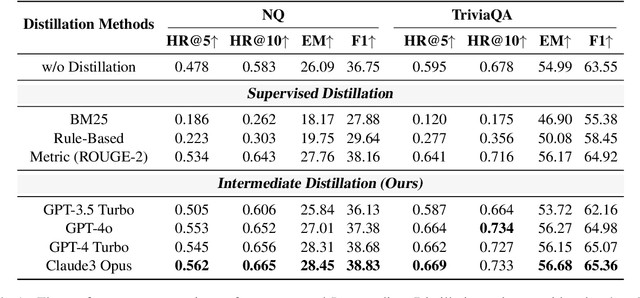
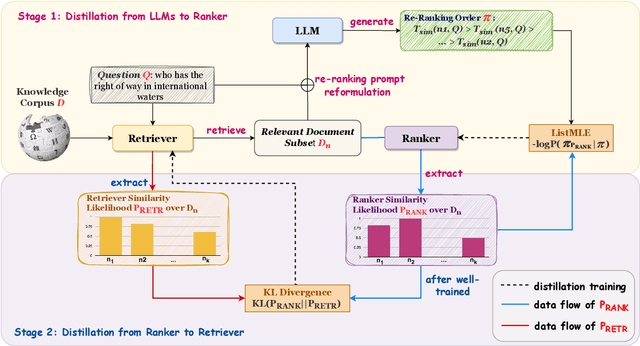
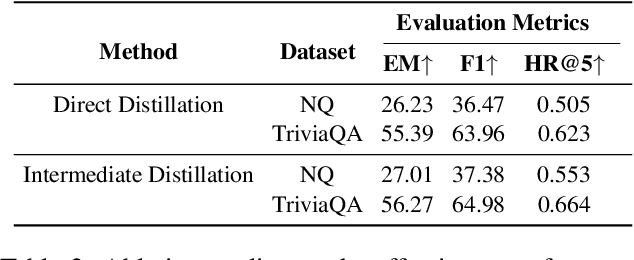
Abstract:Recent research has explored distilling knowledge from large language models (LLMs) to optimize retriever models, especially within the retrieval-augmented generation (RAG) framework. However, most existing training methods rely on extracting supervision signals from LLMs' weights or their output probabilities, which is not only resource-intensive but also incompatible with black-box LLMs. In this paper, we introduce \textit{Intermediate Distillation}, a data-efficient knowledge distillation training scheme that treats LLMs as black boxes and distills their knowledge via an innovative LLM-ranker-retriever pipeline, solely using LLMs' ranking generation as the supervision signal. Extensive experiments demonstrate that our proposed method can significantly improve the performance of retriever models with only 1,000 training instances. Moreover, our distilled retriever model significantly boosts performance in question-answering tasks within the RAG framework, demonstrating the potential of LLMs to economically and effectively train smaller models.
A Systematic Survey of Text Summarization: From Statistical Methods to Large Language Models
Jun 17, 2024



Abstract:Text summarization research has undergone several significant transformations with the advent of deep neural networks, pre-trained language models (PLMs), and recent large language models (LLMs). This survey thus provides a comprehensive review of the research progress and evolution in text summarization through the lens of these paradigm shifts. It is organized into two main parts: (1) a detailed overview of datasets, evaluation metrics, and summarization methods before the LLM era, encompassing traditional statistical methods, deep learning approaches, and PLM fine-tuning techniques, and (2) the first detailed examination of recent advancements in benchmarking, modeling, and evaluating summarization in the LLM era. By synthesizing existing literature and presenting a cohesive overview, this survey also discusses research trends, open challenges, and proposes promising research directions in summarization, aiming to guide researchers through the evolving landscape of summarization research.
MIPI 2024 Challenge on Nighttime Flare Removal: Methods and Results
Apr 30, 2024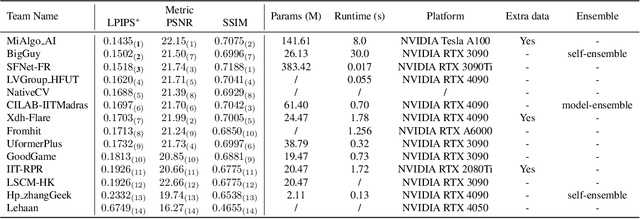

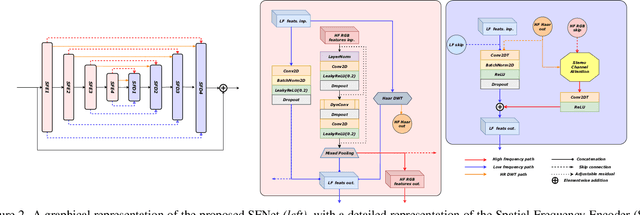
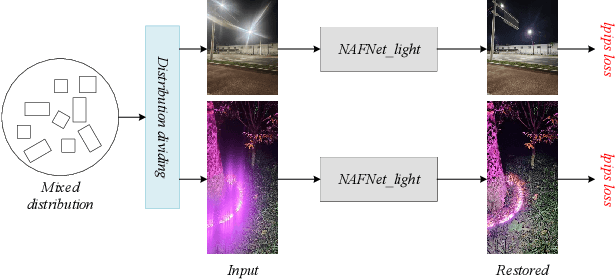
Abstract:The increasing demand for computational photography and imaging on mobile platforms has led to the widespread development and integration of advanced image sensors with novel algorithms in camera systems. However, the scarcity of high-quality data for research and the rare opportunity for in-depth exchange of views from industry and academia constrain the development of mobile intelligent photography and imaging (MIPI). Building on the achievements of the previous MIPI Workshops held at ECCV 2022 and CVPR 2023, we introduce our third MIPI challenge including three tracks focusing on novel image sensors and imaging algorithms. In this paper, we summarize and review the Nighttime Flare Removal track on MIPI 2024. In total, 170 participants were successfully registered, and 14 teams submitted results in the final testing phase. The developed solutions in this challenge achieved state-of-the-art performance on Nighttime Flare Removal. More details of this challenge and the link to the dataset can be found at https://mipi-challenge.org/MIPI2024/.
Unveiling the Magic: Investigating Attention Distillation in Retrieval-augmented Generation
Feb 19, 2024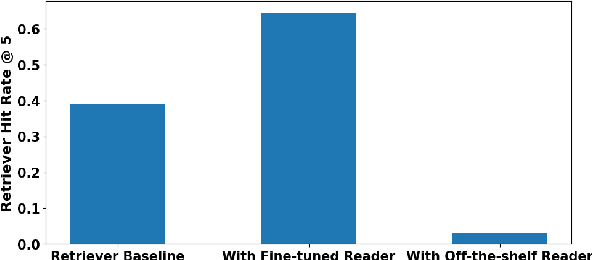
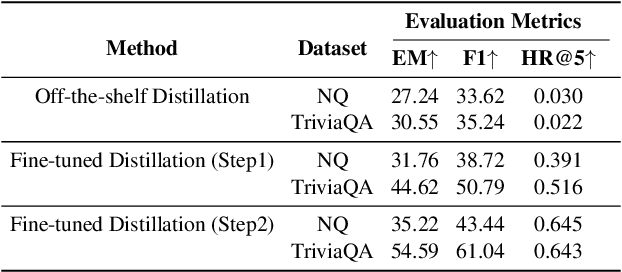


Abstract:Retrieval-augmented generation framework can address the limitations of large language models by enabling real-time knowledge updates for more accurate answers. An efficient way in the training phase of retrieval-augmented models is attention distillation, which uses attention scores as a supervision signal instead of manually annotated query-document pairs. Despite its growing popularity, the detailed mechanisms behind the success of attention distillation remain unexplored, particularly the specific patterns it leverages to benefit training. In this paper, we address this gap by conducting a comprehensive review of attention distillation workflow and identifying key factors influencing the learning quality of retrieval-augmented language models. We further propose indicators for optimizing models' training methods and avoiding ineffective training.
 Add to Chrome
Add to Chrome Add to Firefox
Add to Firefox Add to Edge
Add to Edge